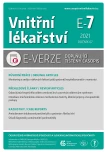Amiodarone induced pulmonary toxicity
Authors:
Martin Hudec 1,2; Petra Vysočanová 1,2; Vojtěch Brázdil 1,2; Martin Poloczek 1,2; Martin Hetmer 1,2; Jiřina; Little 3; Martina Doubková 2,4; Petr Kala 1,2
Authors‘ workplace:
Interní kardiologická klinika Fakultní nemocnice Brno
1; Lékařská fakulta Masarykovy univerzity Brno
2; Klinika radiologie a nukleární medicíny Fakultní nemocnice Brno
3; Klinika nemocí plicních a tuberkulózy Fakultní nemocnice Brno
4
Published in:
Vnitř Lék 2021; 67(E-7): 18-23
Category:
Case reports
Overview
Amiodarone is one of the more frequently used drugs in the treatment of supraventricular and ventricular arrhythmias. Many adverse effects, more or less serious, are associated with its administration. Amiodaron-induced pulmonary toxicity (AIPT) is quite rare but represents one of the most severe adverse effects with high mortality. We present an 80 years old patient, who used amidorane due to paroxysmal atrial fibrillation for several years. Within 3 months, he was repeatedly hospitalized for a bilateral pneumonia. Eventually, AIPT was diagnosed. Early diagnosis, proper therapy of AIPT and changed antiarrhythmic therapy has significantly improved the clinical status of our patient. In this case we demonstrate typical clinical presentations of AIPT as well as the most common diagnostic procedures and recommended treatment methods. Finally, some other commonly used therapeutical options for supraventricular arrhythmias are mentioned. Future options are outlined.
Keywords:
amiodarone – AIPT – amiodarone induced pulmonary toxicity – amiodarone lung
Sources
1. Bexton RS, John Camm A. Drugs with a class III antiarrhythmic action. Pharmacol Ther 1982;17(3): 315-355. doi: 10.1016/0163-7258(82)90020-1.
2. Hrckova Y, Sarapatkova H, Lukl J. Vedlejsi ucinky amiodaronu. Intern Med Pract 2006; 7(6): 288–290.
3. Kodama I, Kamiya K, Toyama J. Amiodarone: ionic and cellular mechanisms of action of the most promising class III agent. Am J Cardiol 1999; 84(9): 20–28. doi:10.1016/ S0002-9149(99)00698-0.
4. Jafari‑Fesharaki M, Scheinman MM. Adverse Effects of Amiodarone. Pacing Clin Electrophysiol. 1998; 21(1): 108-120. doi:10.1111/j.1540-8159.1998.tb01068.x
5. Okayasu K, Takeda Y, Kojima J et al. Amiodarone Pulmonary Toxicity: A Patient with Three Recurrences of Pulmonary Toxicity and Consideration of the Probable Risk for Relapse. Intern Med. 2006; 45(22):1303–1307. doi:10.2169/internalmedicine.45.1800
6. Dusman RE, Stanton MS, Miles WM et al. Clinical features of amiodarone‑ induced pulmonary toxicity. Circulation. 1990; 82(1): 51–59. doi:10.1161/01.CIR.82. 1. 51.
7. Pitcher WD. Southwestern Internal Medicine Conference: Amiodarone Pulmonary Toxicity. Am J Med Sci. 1992; 303(3): 206–212. doi:10.1097/00000441-199203000-00012.
8. Papiris SA, Triantafillidou C, Kolilekas L et al. Amiodarone: Review of Pulmonary Effects and Toxicity. Drug Saf. 2010; 33(7): 539–558. doi:10.2165/11532320-000000000-00000
9. Wood DL, Osborn MJ, Rooke J et al. Amiodarone Pulmonary Toxicity: Report of Two Cases Associated With Rapidly Progressive Fatal Adult Respiratory Distress Syndrome After Pulmonary Angiography. Mayo Clin Proc 1985; 60(9): 601–603. doi:10.1016/S0025- 6196(12)60983-5.
10. Feduska ET, Thoma BN, Torjman MC et al. Acute Amiodarone Pulmonary Toxicity. J Cardiothorac Vasc Anesth. Published online November 2020: S1053077020311745. doi: 10.1053/j.jvca.2020. 10. 060.
11. The drug‑induced respiratory disease website. [cit. 2021-06-26]. Dostupné z WWW:https:// www.pneumotox.com/drug/index/.
12. Gleadhill IC, Wise RA, Schonfeld SA et al. Serial lung function testing in patients treated with Amiodarone: A prospective study. Am J Med 1989; 86(1): 4–10. doi:10.1016/0002- 9343(89)90221-0.
13. Marchlinski FE. Amiodarone Pulmonary Toxicity. Ann Intern Med 1982; 97(6):839. doi:10.7326/0003-4819-97-6-839.
14. Siniakowicz RM, Narula D, Suster B et al. Diagnosis of Amiodarone Pulmonary Toxicity with HighResolution Computerized Tomographic Scan. J Cardiovasc Electrophysiol 2001; 12(4): 431–436. doi:10.1046/j.1540-8167.2001.00431.x.
15. Lošťáková V, Kuna M, Kolek V et al. Drug‑ induced lung injury. Klin Farmakol Farm 2019; 32(4): 21–31. doi:10.36290/far.2018.025.
16. Kubo K, Azuma A, Kanazawa M et al. Consensus statement for the diagnosis and treatment of drug‑ induced lung injuries. Respir Investig 2013; 51(4): 260–277. doi:10.1016/j. resinv.2013. 09. 001.
17. Potpara T, Dagres N, Arbelo E et al. The Task Force for the diagnosis and management of atrial fibrillation of the European Society of Cardiology (ESC): 126.
18. Epstein AE, Olshansky B, Naccarelli GV et al. Practical Management Guide for Clinicians Who Treat Patients with Amiodarone. Am J Med 2016; 129(5): 468–475. doi:10.1016/j. amjmed.2015. 08. 039.
Labels
Diabetology Endocrinology Internal medicineArticle was published in
Internal Medicine

2021 Issue E-7
Most read in this issue
- Amiodarone induced pulmonary toxicity
- Amanita phalloides intoxication: mechanism of toxicity, clinical manifestations and therapeutic approaches
- Pitfalls of diagnosing autoimmune pancreatitis
- Recommendations for safe collection of venous blood by a closed collection system
